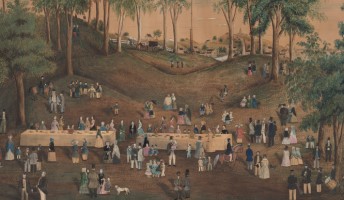Last updated: January 4, 2024
Lesson Plan
Peace Picnics and Community in Hopedale

- Grade Level:
- High School: Ninth Grade through Twelfth Grade
- Subject:
- Literacy and Language Arts,Social Studies
- Lesson Duration:
- 90 Minutes
- State Standards:
- PS.1, PS.3, PS.4, PS.6, PS.7, USI.T4.1, USI.T4.2, USI.T5.2, RCA-H.1, RCA-H.2, SCLA.1, SCLA.3,
- Thinking Skills:
- Understanding: Understand the main idea of material heard, viewed, or read. Interpret or summarize the ideas in own words. Analyzing: Break down a concept or idea into parts and show the relationships among the parts. Evaluating: Make informed judgements about the value of ideas or materials. Use standards and criteria to support opinions and views.
Essential Question
How do you think community and speech can create social change or influence movements?
Objective
Students will read primary source accounts about anti-slavery meetings and celebrations of independence in Hopedale, MA, before the Civil War.
Students will consider how people use speeches and the power of print to create persuasive arguments.
Background
In 1842, a group of like-minded individuals created a commune called Hopedale in a rural area of the Blackstone River Valley. Under the leadership of minister Adin Ballou, people came to Hopedale to live out their values, which included Christian non-resistance and abolition. In addition to being a meeting place for other activists, Hopedale was also a place for freedom seekers to find sanctuary in their journey of self-liberation.
One especially important annual event was the picnic community members held to celebrate the Emancipation of the British West Indies. These picnics were not held in a church, community hall, school, or government building, but in a simple grove. In that space, thousands of people gathered through the years and used the power of speech to spread ideas and to advance the abolition movement.
While reading descriptions of the celebration, speeches, and poems written within the community, students will learn about the network of abolitionists who either lived in or met up in Hopedale. Educators will find primary sources and activities in this plan designed to show the ways that social movements, such as abolition, were driven by communication.
This lesson plan was prepared by Hopedale educator Susan Scanlon and edited by park staff.
Preparation
Primary Source Documents:
Nelsons Grove and Key Abolitionists Packet
Descriptions of the Hopedale Community Picnics
Abolition and Anti-Slavery Texts in Hopedale
This lesson plan draws from primary sources including Adin Ballou’s History of the Hopedale Community, Ballou’s Autobiography of Adin Ballou, the community newspaper The Practical Christian, and an early edited collection of local histories called Hopedale Reminiscences. Students will also gain exposure to contemporary voices writing about Hopedale through texts such as William Lloyd Garrison’s newspaper The Liberator. This plan also includes excerpts from speeches delivered by activists at gatherings similar to the Hopedale picnics to supplement gaps in the archival record.
Materials
This document will provide background information which is helpful to review before starting the lesson plan
Download Hopedale Lesson Plan Background Info
This document will provide background information on abolitionists who visited or lived in Hopedale, MA
Download Abolitionist and Bios
This document contains primary source transcripts necessary for completing this lesson plan.
Download Abolitionists and AntiSlavery Primary Sources
This document contains a series of primary sources related to Hopedale Community Picnics
Download Descriptions of Hopedale Community Picnics - Primary Sources
Lesson Hook/Preview
This speech-focused lesson highlights the importance of community events and networks of communication among abolitionists in Hopedale, MA.
Procedure
- Review the primary sources and background document on Hopedale.
- After reading some or all the above excerpts, try to imagine a peace picnic in the past.
- On a blank sheet of paper, draw a picture of how you imagine the grove to be based off the descriptions you have read. After drawing, identify the most important features of your depiction, and which of those features may be missing from the space if you were to draw the grove on a day where no one was gathered.
- Continue the conversation with these questions:
- A number of people have written about the Hopedale abolition picnics, including people who attended as children, as well as adult abolitionists, members of the community, and outsiders. All have noted that a wide variety of people were in attendance. These sources indicate that fugitives, free black and white abolitionists, women, men, children, community members, outsiders, poets, lecturers, singers, preachers all came to the grove.
- How did the backgrounds of those individuals, both the ones writing their accounts of the day as well as of those they described attending, influence their experience at the events?
- Hopedale was and is still a small community. Why was it important for abolitionists, and especially fugitives, to speak here, and in surrounding communities? What was their impact? How could it have influenced the abolitionist movement and its eventual success?
- Where are important events held in your community?
Enrichment Activities
Visiting the Site: You can visit Nelson’s Grove in Hopedale today. It covered the area where the Sacred Heart Church and its parking lot is on Hopedale Street, as well as across the street in the areas of Thwing St., Nelson St., and Cook St. It also covered the area on the opposite side of the railroad tracks. To the right of the entrance to the church’s parking lot, there is a plaque and marker identifying the area as the historical Nelson’s Grove. You can find more information here: https://www.hope1842.com/abolplaque-html/.
Additional Resources
Additional Resources: For more information on Hopedale’s History, visit Dan Malloy’s website, hope1842.com.
